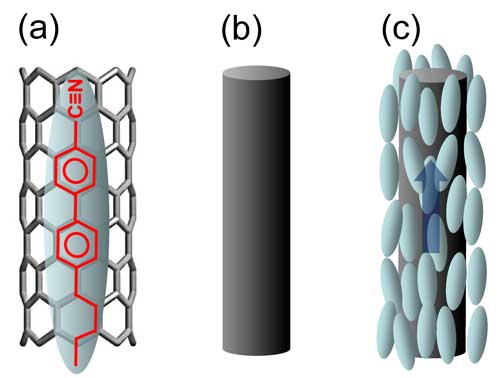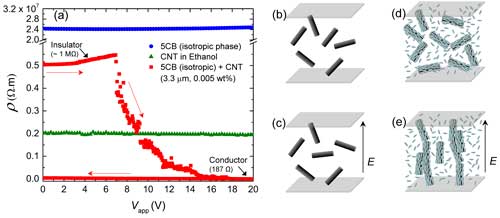| Posted: Nov 01, 2016 | |
Connecting two electrodes by liquid crystal-guided carbon nanotube wires |
|
| (Nanowerk Spotlight) Carbon nanotubes (CNTs) being highly electrically conductive along the tube axis, have gained great research interests in recent years for connecting two conducting electrodes at the nanoscale – where the CNTs can be integrated into a micro- or nanoelectronic system. | |
| Due to the anisotropic nature of conductivity, CNTs have potential applications in nanoscale switches and nano-electromechanical systems (NEMS). | |
| Therefore, the orientational control of CNTs has drawn a great deal of research interest in nanotechnology. | |
| Assistant professor Rajratan Basu and his student Midshipman Alfred Garvey in the Department of Physics at the United States Naval Academy have developed a technique to bridge two electrical conductors by assembling CNTs guided by liquid crystals (LCs). | |
| They report their findings in Journal of Applied Physics ("Insulator-to-conductor transition in liquid crystal-carbon nanotube nanocomposites"). | |
| "CNTs don't have any permanent dipole moment, and therefore, they do not interact with a uniform electric field," Basu explains to Nanowerk. "When a small quantity (∼10-3 wt%) of carbon nanotubes is doped in a LC, the LC molecules self-assemble themselves at the CNT surface due to π-π electron stacking, creating pseudonematic domains (PNDs) surrounding the CNTs." See Figure 1. | |
 |
|
| Figure 1: Schematic illustrations of LC-CNT interaction: (a) anchoring of an LC molecule on the CNT surface due to π-π electron stacking. The blue ellipsoid is an LC molecule and the black cylindrical honeycomb structure is a CNT surface. The molecular structure of 5CB LC is shown in red in the ellipsoid on the CNT surface. The π-π electron stacking is illustrated by matching the LC’s benzene rings on the CNT-honeycomb structure; (b) a simplified version of a CNT; (c) a pseudonematic domain surrounding a CNT. The arrow shows the local director of the pseudonematic domain. (© AIP Publishing) | |
| Basu and Garvey show that an LC platform can be used to construct CNT wires that can electrically connect the two electrodes of a parallel plate capacitor-like cell. The PNDs surrounding the CNTs have dielectric anisotropy. Therefore, they experience a torque when an electric field is applied. Without the external field, the PNDs are randomly orientated in the isotropic phase as shown in Fig. 2(d). | |
| When the E field increases – i.e. the voltage is ramped up across the cell – the PNDs start to align along the field, and the CNTs being embedded in the PNDs, also follow the rotation. During this rotational process, multiple PND-encapsulated CNTs find each other and form a wire-like structure due to their natural tendency of entanglement. | |
| When the length of the CNT-wire is grown above the cell thickness, the two get electrically connected, as schematically shown in Fig. 2(e), and the contact resistance of the system drops to 187 Ω from 1 MΩ, exhibiting an insulator-to-conductor transition. See Fig. 2(a). | |
 |
|
| Figure 2: (a) Resistivity p as a function of applied voltage Vapp in 3.3 µm cells for (i) pure 5CB LC in the isotropic phase at T = 40 °C, (ii) CNT (0.005 wt.%)+ethanol in room temperature, and (iii) 5CB+CNT 0.005 wt.% in the isotropic phase at T = 40 °C; (b), (c) schematic representation of CNTs in ethanol when the field is off and on, respectively; (d) the presence of pseudonematic domains surrounding the CNTs in the isotropic phase when the field is off; (e) the construction of CNT- wires guided by the pseudonematic domains when the field is applied in the isotropic phase. (© AIP Publishing) (click on image to enlarge) | |
| "The scientific broad impact of these findings will be very strong in understanding the basic science behind the interactions of LCs with CNTs and the applications on nanoscale LC alignments at the nanoscale interface," concludes Basu. | |
| These findings will likely open up new research areas, such as their potential applications as LC-guided CNT-wiring in nanoelectronics. | |
| This research was supported by the Office of Naval Research (award # N0001416WX01530). | |
 By
Michael
Berger
– Michael is author of three books by the Royal Society of Chemistry:
Nano-Society: Pushing the Boundaries of Technology,
Nanotechnology: The Future is Tiny, and
Nanoengineering: The Skills and Tools Making Technology Invisible
Copyright ©
Nanowerk LLC
By
Michael
Berger
– Michael is author of three books by the Royal Society of Chemistry:
Nano-Society: Pushing the Boundaries of Technology,
Nanotechnology: The Future is Tiny, and
Nanoengineering: The Skills and Tools Making Technology Invisible
Copyright ©
Nanowerk LLC
|
|
|
Become a Spotlight guest author! Join our large and growing group of guest contributors. Have you just published a scientific paper or have other exciting developments to share with the nanotechnology community? Here is how to publish on nanowerk.com. |
|
